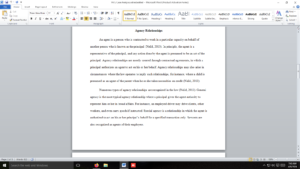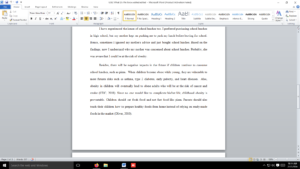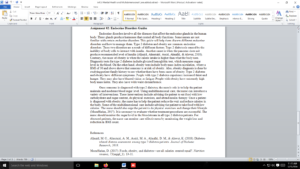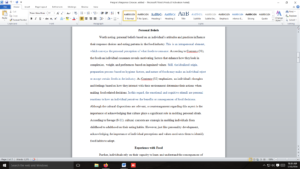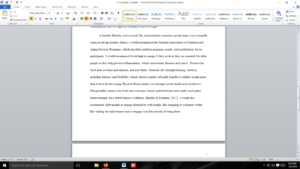Question Description: Instructions
This assignment is a full draft of your Argument Research PaperPreview the document. This draft will demonstrate the argument and writing techniques studied in the course and will build upon the steps you have taken in all the previous weeks toward developing your Argument Research Paper. This draft is expected to meet all of the Argument Research Essay requirements for writing, content, length, and sources.
Writing Requirements for the Argument Research Essay First Draft, Due in Week 5, and for the Argument Essay Final Draft, Due in Week 7
Correct use of APA guidelines for the following:
Headers with pagination
Title Page
Margins, spacing, and paragraph indentation
APA in-text citation and referencing for all sources
Do not divide your essay into sections.
Do not use headings within your paper to indicate changes in topic. While longer APA essays and particular types of APA writing, such as scholarly articles, employ APA-style bolded headings to divide portions of the writing, you are writing a shorter academic essay. Your shift from one paragraph to the next should be signaled through your use of the effective transition and topic sentence rules we have practiced.
6-8 full pages for the essay itself, not including title page or references
Effective structure, including your introduction paragraph, your body paragraphs, and your conclusion paragraph
Use of third-person throughout. Focus on the topic, not on you nor on the essay. In other words: no first-person “I,” and no referring to the essay, such as “In this essay.”
At least 5 scholarly sources visibly used, cited, and referenced
Refer to the full Argument Research Essay Rubric
Your instructor will grade and offer feedback on this draft to help set you up toward additional success with your final draft in Week 7. In Week 6, you will post your draft to your peer review group area in discussion to also receive their feedback.
Grading: This activity will be graded using the Argument Research Essay Rubric.
Course Outcomes (CO): 3, 5, 6
Due Date: By 11:59 p.m. MT on Sunday
Rubric
ENGL147 Week 5 Assignment Rubric (90 pts)
ENGL147 Week 5 Assignment Rubric (90 pts)
Criteria Ratings Pts
This criterion is linked to a Learning OutcomeLength
5.0 pts
Meets length requirement (6-8 pages, not including title page or references).
4.25 pts
Length is 5 pages, not including title page or references.
3.75 pts
Length is 4 pages, not included title page or references.
3.0 pts
Length is 3 pages, not including title page or references.
0.0 pts
Length is fewer than 3 pages, not including title page or references.
5.0 pts
This criterion is linked to a Learning OutcomeAPA Paper Format
5.0 pts
The essay is formatted in correct APA Style for the following items: header with pagination, correct margins and spacing, indentation of the first line of each paragraph. The paper does not use sections or headings within the essay.
4.25 pts
The essay is missing or has errors in 1-2 elements of the following: header with pagination, correct margins and spacing, indentation of the first line of each paragraph. The paper does not use sections or headings within the essay.
3.75 pts
The essay is missing or has errors in 3-4 elements of the following: header with pagination, correct margins and spacing, indentation of the first line of each paragraph. The paper may incorrectly include section divisions or headings within the essay.
3.0 pts
The essay is missing or has errors in 5 or more elements of the following: header with pagination, correct margins and spacing, indentation of the first line of each paragraph. The paper may incorrectly include section divisions or headings within the essay.
0.0 pts
No effort
5.0 pts
This criterion is linked to a Learning OutcomeIntroduction and Thesis Statement
8.0 pts
The introduction paragraph is highly effective and clear. The introduction paragraph begins with a viable, appropriate attention-getting technique, offers a clear but brief overview of the existing debate, and presents a narrow argument thesis in which the writer takes a clear stance within the debate. The writer avoids using first-person and second-person and avoids referring to the paper itself.
6.8 pts
The introduction paragraph includes the necessary components but may be lacking in clarity, strength, or appeal in one of the following areas: a viable, appropriate attention-getting technique, a clear but brief overview of the existing debate, and a narrow argument thesis in which the writer takes a clear stance within the debate. Or, the writer may use first-person or second-person or may refer to the paper itself.
6.0 pts
The introduction paragraph does not include one of the required components, or the paragraph needs much work in one or more of the following: a viable, appropriate attention-getting technique, a clear but brief overview of the existing debate, and a narrow argument thesis in which the writer takes a clear stance within the debate. The writer may use first-person or second-person or may refer to the paper itself.
4.8 pts
The introduction paragraph does not include one or more of the required components, or the paragraph needs much work in two or more of the following: a viable, appropriate attention-getting technique, a clear but brief overview of the existing debate, and a narrow argument thesis in which the writer takes a clear stance within the debate. The writer may also use first-person or second-person or may refer to the paper itself.
0.0 pts
No effort
8.0 pts
This criterion is linked to a Learning OutcomeBody of the Essay: Argument
12.0 pts
In each body paragraph, the thesis argument is forwarded with strong and effective use of multiple argument techniques. Supporting and opposing arguments are richly developed and are presented and analyzed with the writer’s voice as the driving force of each paragraph. The writer avoids using first-person and second-person and avoids referring to the paper itself.
10.2 pts
Body paragraphs forward the thesis argument well but could be more effective in one of the following: use of multiple argument techniques, rich development of supporting and opposing arguments, and the writer’s voice as the driving force. Or, the writer may sometimes use first-person or second-person or may refer to the paper itself.
9.0 pts
Body paragraphs forward the thesis argument but could be more effective in some of the following: use of multiple argument techniques, rich development of supporting and opposing arguments, and the writer’s voice as the driving force.The writer may use first-person or second-person or may refer to the paper itself.
7.2 pts
Body paragraphs fall short of fully forwarding the central argument because of notable deficits in the use of multiple argument techniques, in rich development of supporting and opposing arguments, or in the writer’s voice as the driving force. The writer may use first-person or second-person or may refer to the paper itself.
0.0 pts
No effort
12.0 pts
This criterion is linked to a Learning OutcomeBody of the Essay: Paragraph Development
10.0 pts
The student’s voice is the driving force of each paragraph. Each paragraph includes all of the following: a clear topic sentence in the student’s voice, a brief discussion of the point at hand in the student’s voice, a smooth and clear shift from student’s voice to source material via signal phrases, a brief and clear presentation of source material, a clear indication of when the student’s voice begins again after the source material, and a rich interpretation and analysis in the student’s voice of the source material as related to the overall thesis and/or to the specific argument point at hand.
8.5 pts
The student’s voice is often the driving force of each paragraph, but some paragraphs may be missing some of the following: a clear topic sentence in the student’s voice, a brief discussion of the point at hand in the student’s voice, a smooth and clear shift from student’s voice to source material via signal phrases, a brief and clear presentation of source material, a clear indication of when the student’s voice begins again after the source material, and a rich interpretation and analysis in the student’s voice of the source material as related to the overall thesis and/or to the specific argument point at hand.
7.5 pts
The student’s voice is often the driving force of each paragraph, but many paragraphs are missing some of the following: a clear topic sentence in the student’s voice, a brief discussion of the point at hand in the student’s voice, a smooth and clear shift from student’s voice to source material via signal phrases, a brief and clear presentation of source material, a clear indication of when the student’s voice begins again after the source material, and a rich interpretation and analysis in the student’s voice of the source material as related to the overall thesis and/or to the specific argument point at hand.
6.0 pts
The student’s voice is not often the driving force of all paragraphs because most paragraphs are missing much of the following: a clear topic sentence in the student’s voice, a brief discussion of the point at hand in the student’s voice, a smooth and clear shift from student’s voice to source material via signal phrases, a brief and clear presentation of source material, a clear indication of when the student’s voice begins again after the source material, and a rich interpretation and analysis in the student’s voice of the source material as related to the overall thesis and/or to the specific argument point at hand.
0.0 pts
No effort
10.0 pts
This criterion is linked to a Learning OutcomeBody of the Essay: Organization and Flow
8.0 pts
Throughout the essay, the writing flows smoothly with effective transitions. The writing employs strong, clear, varied word choice that clarifies ideas and demonstrates good sentence variety. The essay is organized effectively and logically from start to finish.
6.8 pts
Throughout most of the essay, the writing flows smoothly with effective transitions. The writing usually employs strong, clear, varied word choice that clarifies ideas and demonstrates good sentence variety. The essay reflects that an organizational plan has been employed.
6.0 pts
In some places throughout the essay, the writing flows smoothly with effective transitions. There is some evidence of clear, varied word choice and sentence variety. The organization of paragraphs may not be optimal.
4.8 pts
Throughout the essay, the writing may be choppy due to a lack of sentence variety, word choice, or transitions. The organization of paragraphs from start to finish in the essay might be confusing or otherwise ineffective.
0.0 pts
No effort
8.0 pts
This criterion is linked to a Learning OutcomeSources: Quality and Number
10.0 pts
Five scholarly sources are visibly used in the essay itself and are all referenced and cited with enough information needed to determine their scholarly nature.
8.5 pts
Five sources are visibly used in the essay itself, but some may not include enough information needed to determine their scholarly nature.
7.5 pts
Five sources may be used, but 1-2 may not be scholarly. Or, fewer than five sources are used or some are not visibly integrated into the writing.
6.0 pts
Five sources may be used, but 3 or more may not be scholarly. Or, fewer than five sources are used and many or most are not visibly integrated into the writing.
0.0 pts
No effort
10.0 pts
This criterion is linked to a Learning OutcomeSources: Application and Integration
8.0 pts
Each time a source is used within the essay, it is well-previewed in the student’s voice and is smoothly integrated with a signal phrase or with correct integration into a student’s sentence. Each time a source is used, it is highly relevant to the point at hand and is effective in the context of the argument. The student has chosen to paraphrase or quote according to best practices. Sources comprise a small portion of each paragraph and are never used in the topic sentence or final sentence of a paragraph. Sources are cited directly after use, never at the end of the paragraph.
6.8 pts
Almost every time a source is used within the essay, it is well-previewed in the student’s voice and is smoothly integrated with a signal phrase or with correct integration into a student’s sentence. The source may not be clearly relevant to the point at hand or in the context of the argument. The student may need to make better choices between paraphrasing or quoting according to best practices. Sources may be over-used in some paragraphs or may be used in the topic sentence or final sentence of a paragraph. Sources may be cited at the end of a paragraph vs. directly after their use.
6.0 pts
Source application and integration may fall short and may require work to meet some of the following standards: sources well-previewed in the student’s voice, smoothly-integrated with a signal phrase or with correct integration into a student’s sentence, clearly relevant to the point at hand or in the context of the argument, well-informed in choice of paraphrase or quotation, minimally used to maintain writer’s voice, and effectively placed sources and citations.
4.8 pts
Source application and integration may fall short and may require work to meet many of the following standards: sources well-previewed in the student’s voice, smoothly-integrated with a signal phrase or with correct integration into a student’s sentence, clearly relevant to the point at hand or in the context of the argument, well-informed in choice of paraphrase or quotation, minimally used to maintain writer’s voice, and effectively placed sources and citations.
0.0 pts
No effort
8.0 pts
This criterion is linked to a Learning OutcomeEssay Conclusion
8.0 pts
The conclusion is succinct and powerful, avoiding verbatim repetition of material from the introduction or from the paper. The conclusion flows well from the final body paragraph, reiterates the thesis concept in a unique way, and leaves the reader thinking with a look at larger contexts while staying keenly on-topic. The writer avoids using first-person and second-person and does not refer to the essay itself.
6.8 pts
The conclusion is succinct and powerful, but may include a small amount of verbatim repetition of material from the introduction or from the paper. The conclusion may flow well from the final body paragraph and addresses larger contexts, but in a way that may not be effective or powerful. The writer may use first-person or second-person or may refer to the esay itself.
6.0 pts
The conclusion is ineffective in some of the following areas: power and conciseness, unique wording, smooth flow, a thought-provoking ending, third-person point of view.
4.8 pts
The conclusion is missing multiple required elements or is highly ineffective due to wordiness, repetition, length (too short or too long), choppiness, a lack of impact, and/or the use of first-person or referring to the essay itself.
0.0 pts
Sources are not cited.
8.0 pts
This criterion is linked to a Learning OutcomeAPA Citation and Referencing
8.0 pts
All in-text citations and references are formatted in correct APA Style, and the references page is formatted correctly: The word References is centered at the top, the entire page is double-spaced uniformly, the list is alphabetized, and all but the first line of each source is properly indented.
6.8 pts
In-text citations and references may have minor errors in APA Style, and the references page may show errors in 1-2 of the following: The word References is centered at the top, the entire page is double-spaced uniformly, the list is alphabetized, and all but the first line of each source is properly indented.
6.0 pts
In-text citations and references may have persistent errors in APA Style, or the references page may show errors in 3 of the following: The word References is centered at the top, the entire page is double-spaced uniformly, the list is alphabetized, and all but the first line of each source is properly indented.
4.8 pts
In-text citations and references may have major errors in APA Style, may not include enough information to fully identify the source, or 4 or more of the following: The word References is centered at the top, the entire page is double-spaced uniformly, the list is alphabetized, and all but the first line of each source is properly indented.
0.0 pts
Sources are not cited or are cited poorly enough that the nature of the sources is overwhelmingly unclear.
8.0 pts
This criterion is linked to a Learning OutcomeWriting: Mechanics & Usage
8.0 pts
The writing is free of errors in grammar, spelling, and punctuation that would detract from a clear reading of the paper.
6.8 pts
The writing contains a few errors in grammar, spelling, and punctuation, but the errors do not detract from a clear reading of the text.
6.0 pts
The writing contains some errors in grammar, spelling, and punctuation that need to be addressed for a clearer reading of the paper.
4.8 pts
The writing contains several errors in grammar, spelling, and punctuation that impede a clear reading of the paper.
0.0 pts
No effort
8.0 pts
Total Points: 90.0
Answer preview
The COVID-19 pandemic has disrupted systems, including virtual learning, which has increased distress as people try to cope with new systems. Working at home and remote learning has many odds and stresses not previously experienced. The pressure to the various stakeholders to adapt to new systems and fear that such investment will not be sustained is a major cause of anxiety disorder. For instance, Fleming (2020, April 25) explains that many children struggle to adapt to remote learning. The benefits of flexibility in learning are only localized for those who are socially advantaged. Not all physical environments support remote learning, and technical problems are a major cause of distress. Parents, teachers, and students are worried about what the future will bring and how it will affect them. University students have also experienced distress in the era of COVID-19. According to Hadi et al. (2020), social field students have reported difficulties contacting lecturers for statistic tasks, which is a major cause of distress.
[1845 Words]
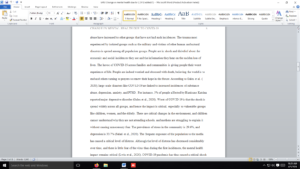
Change in mental health due to COVID-19
